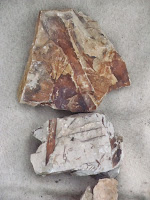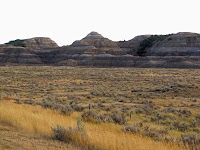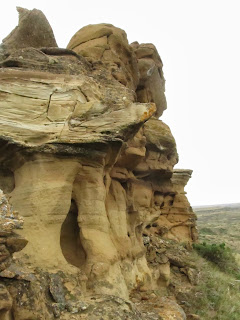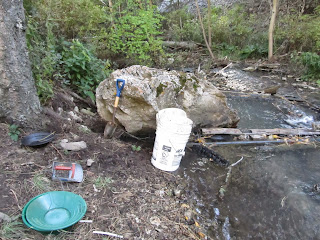GOLD, DINOSAURS, & GIANT SEQUOIAS
 |
| Badlands near Havre |
We were leaving North Dakota and heading west on Highway 2
through Montana. Looking at the map, it
appeared that it would be a quick trip.
Not much to see along the way, we thought; a few sites here and there, a
couple of small town museums, and vast expanses of farmland. Now, a week and a half later, we were
still just a couple hundred miles into the state, and boy were we wrong about
Northeastern Montana.
Southeastern Montana is known for its beautiful agates. Southwest Montana is famous for its gold
and copper mines, towering mountains, and amazing geologic wonders of
Yellowstone National Park. Northwest
Montana has Glacier National Park. And
that vast, flat and seemingly uninteresting stretch of Highway 2 in Northeast
Montana has way more than initially meets the eye. We followed the Lewis and Clark trail, the Milk River and the
Hi-Line- a railroad line that, along with the Great Northern Railway, was
responsible for connecting the remote northwest with the rest of the world and
establishing towns in this portion of Montana.
We visited Forts, Indian Reservations, some Native American Sites, and
historic towns with buildings dating back to the 1890’s.
But hidden treasures also abound in this stark yet
incredibly beautiful portion of the state.
Besides the Lewis and Clark trail, there is also the Dinosaur
Trail. Besides plains and grasslands,
there are badlands and mountain ranges where fossils, interesting rocks, and
amazing scenery abound. Northeast
Montana is famous in paleontology circles for having produced some of the most
complete dinosaur skeletons in the entire world, including a “mummified”
dinosaur fossil named “Leo” who was fossilized with skin, muscles, and stomach
contents intact. (Go to
http://www.mummydinosaur.com/ for more info on Leo). Along the Dinosaur Trail are some wonderful museums housing both replicas and actual dinosaur
fossils, along with numerous “dino digs” where Dinosaur fossils are still being
recovered. Go to
http://mtdinotrail.org/ for all the details, maps, and locations of sites along the Dinosaur Trail. One of the best museums we
went to was the Great Plains Dinosaur Museum and Field Station in Malta, where
actual dinosaur and other fossils are housed and studied as they are brought in
from the digs. The website for the Malta Dinosaur Museum is
www.greatplainsdinosaurs.org. There are lots of great photos there of dinosaur and other fossils found in Northeast Montana.
 |
| Leaf Fossils from Fort Peck area. |
In the badlands around Fort Peck, Malta, and Havre, fossils
abound. Besides dinosaurs, other
fossils found throughout this area include ammonites, baculites, and marine
fossils like crabs and lobsters. The
petrified wood of the MetaSequoia (an ancestor of the giant Sequoia) is found in several locations, as well as
plants of the Late Cretaceous period.
We collected leaf and plant fossils from several of these areas, as well
as some interesting iron oxide and silicate concretions and lots of petrified
wood. Another great location for fossil
hunting is Fossil Hill in the Little Rocky Mountains. Crinoids, shellfish, brachiopods, and even dinosaur fossils
have been recovered there.
 |
| Old Pegasus Mine by Zortman |
South of Malta, rising up out of the plains to nearly 7000
feet are the Little
th century, miners Pike Landusky and Pete Zortman struck gold in
this corner of the Little Rockies.
Mining continued there throughout the 1900’s. Pegasus Gold Corporation was formed in 1979 and heap-leach mined
in the Little Rockies until the late 1990’s when the mines were shut down due
to environmental pollution from cyanide spills. The closed down Pegasus mines that sit above the townsites are
currently undergoing reclamation, but there is still plenty of gold to be found
in the streams around Zortman and Landusky. Both Swift Gulch and South Bighorn Creek near Zortman contain placer gold washed down from the now closed
Pegasus Mine. There are some claims located along Swift Gulch, but other spots within the national forest are open for panning.
Rocky Mountains.
In addition to fossils, the Little Rocky Mountains boast beautiful
forests, the old mining towns of Zortman and Landusky, and Montana’s
easternmost gold deposits. In the late
19
To get to the Little Rocky Mountains and Zortman, take 191 South for approximately 60 miles. The road to the GPAA claim is currently washed out and inaccessible, but there are areas to access the streams in the National Forest behind Zortman. This area is currently in reclamation due to cyanide leaching contamination, so be careful where you pan.
 |
| The Pegasus Mine in Landusky |
Also, in Landusky, just west of Zortman on the other side of the Little Rockies, there are a few streams containing placer gold runoff from the closed Pegasus Mine location in Landusky. We spent the day panning for gold at Montana Gulch in Custer National Forest near Landusky. There is a nice National Forest campground there, right at the beginning of town which provides nice sites with easy access to the stream. We didn't find any color that day, but it was cold and late in the afternoon, so we only panned for a very short time. I'm sure we would have found a little color if we had spend more time there.
 |
| The Lobby of the Zortman Hotel |
Fossil hill is located behind the Zortman dump and is full of oysters, belemnites, crinoids, ammonites, and other small marine fossils. Portions of this land are private property, but it is easy to secure permission to look for fossils there. The proprietors of the Zortman Hotel are friendly and knowlegeable. They will be willing to help.
In the Fort Peck area, head south on Route 24 into the Badlands to find fossil collecting areas. This area is BLM land dotted with
 |
Badlands near Fort Peck
|
privately owned ranches. We drove about 12 to 15 miles south of the Fort Peck Dam, and then turned on a gravel road that went back into the badlands. We searched several different locations. A few produced nice petrified wood of the Metasequoia, and one site yielded nice plant fossils of leaves and reeds. The plant fossils were in a reddish shale. We had to break open the layers to expose the fossils. The petrified wood here is pale grays and whites with streaks of brown and black and pretty pockets of quartz crystals. It is found on the surface where it has eroded out of the volcanic tuff, and in some places it is concentrated at the bottoms of washes.
 |
Montana Petrified Wood
|
Northeastern Montana holds many surprises for those who are
willing to look beyond its seemingly
uninteresting landscape to discover its
secret treasures. We will be open
Quartzsite at Space A37 in Rice Ranch shortly, so watch the paper for the
announcement. We will have rocks,
fossils, and petrified wood from Northeastern Montana, and more, for sale. Meanwhile you can order through the website,
by email, or by phone at 605-376-8754 until then. See ya in Quartzsite and hope you have many happy prospecting
adventures along the way!
 |
| Badlands near Fort Peck |
 |
| Panning in Montana Gulch, Landusky |
 |
| Washes like these yield good petrified wood. |
 |
| Plant fossils we found in the Badlands near Fort Peck |
 |
| Badlands near Fort Peck where we found alot of Petrified Wood. |














No comments:
Post a Comment